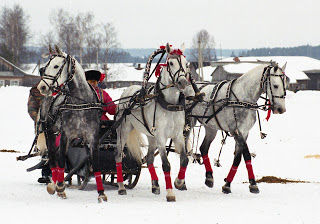The prompt for Carpe Diem Weekend Meditation #44 Troiku Challenge: Against the Sky
starts with two haiku by Yosa Buson (translated by Robert Hass) to be used to create
a “fusion” haiku, which is then to be the base to create a troiku.
before the white chrysanthemum
the scissors hesitate
a moment
calligraphy of geese
against the sky —
the moon seals it
Yosa Buson
~~~~~~~
semaphore at night
calligraphy in the sky
moon waits behind clouds

 semaphore at night
semaphore at night
element of mystery
embracing pale light
calligraphy in the sky
secrets held in shifting shapes
crafted by wind’s breath
moon waits behind clouds
displaying quiet patience
secret deciphered

A troiku is three haiku, with each of the three lines from a suggested haiku as the first line of each haiku in the troiku. It’s not always possible to have a 5-7-5 format in the second haiku, due to the limitations of the suggested haiku. The name of the form is derived from “troika,” a sled or carriage drawn by three horses harnessed side-by-side, an iconic symbol of Imperial Russia.

Image sources:
ukiyo-e.org (Flying Geese, by Kamisaka Sekka)
Wikimedia Commons (troika)
Beautiful and brilliant!
LikeLiked by 1 person
Thanks!
LikeLiked by 1 person
Such an Awesome series of poetic beauty! (@–>–)
LikeLiked by 1 person
Thank you!
LikeLike
A wonderful fusion-haiku-troiku, Ken!
LikeLiked by 1 person
Thank you, Kim.
LikeLike
This is so creative. I love the layout. I had no idea such things were possible on WordPress.
LikeLiked by 1 person
Thank you.
Smoke & mirrors. 😉
LikeLiked by 1 person
Elements of mystery…always and of course! (K)
LikeLiked by 1 person
Keep the reader thinking. ;!
LikeLiked by 1 person
the use of “semaphore” is interesting … very interesting indeed …. and unusual …. and honestly, I’m not sure which side of the fence I sit with this use, but that’s okay, I’ll linger longer …. because I like the word very much, and the general image it conjures, because geese do look exactly like this in flight … and mysterious messages are codes to be understood …
and I particularly like the 2nd haiku in the troiku – writing in the sky … indeed …. it’s really very elegant for the imagery 🙂
LikeLiked by 1 person
To be honest, I crafted this with the thought of the moon being the source of the semaphore, obscured/revealed/obscured by the clouds. The calligraphy was almost an afterthought, the geese inferred, but never mentioned – and then I found the art that seemed to hold it all.
LikeLiked by 1 person
ah, well thank you for sharing these ideas here, I really appreciate it Ken.
By the light of day, I sit with your fusion + haiku + troiuk and realize, I clearly interpreted the haiku in a completely different way …. I was thinking more on the geese, and how they fly at night … sigh – my apologies for having been too tired perhaps when I visited.
and yes, I can now much better understand how you came to the moon as semaphore …
but, I still like the idea of geese writing on the sky, so I’m also going to keep that within my heart as I read and savour your poems.
Thanks again Ken for your explanations and I hope I wasn’t being too forward in my original comment.
LikeLiked by 1 person
You were not at all forward. The beauty of poetry lies in the message found by each reader.
LikeLiked by 1 person
very true indeed 🙂 (but I really need to stop reading poetry and blogs etc. when dead tired! LOL – I feel a bit foolish 😉 ) Cheers!
LikeLiked by 1 person
Stunningly beautiful, Ken–and yes, the mystery, too.
Semaphore is a beautiful word, but I have to admit that when I hear it, I first think of a Monty Python skit where they do the semaphore version of Wuthering Heights. 🙂
LikeLiked by 1 person
Thank you, Merril.
lol @ Monty Python
Imagine Basho in his travels, arms moving at the first sight of a frog jumping, or flags waving as geese fly by the moon.
LikeLiked by 1 person
Hahahaha I love it!
LikeLiked by 1 person
I am sure I had heard semaphore before, but looked it up as a reminder… and thusly you inspired:
(maybe I’ll work it into a troiku another time. – Thank you. Lovely verses.
Hmm… might add it to Frank’s haikai this week 😉
semaphore on shore
lifeguards communicating
a top tower chairs
©JP/dh
LikeLiked by 1 person
I like that,
I might have been more clear in my impression of the changing shape of the moon being similar to moving flags, but that’s the brevity of haiku. One nice thing about troiku is it’s similarity to renga in adding flow.
LikeLiked by 1 person
I (yep, just) managed the trioku… I’ll post it tomorrow –
Thanks again. I like that we can inspire each other.
I think haiku lends itself to interpretation because of its brevity and I think that is just fine. 🙂
LikeLiked by 1 person
I’ll watch for it.
LikeLiked by 1 person
You did it again Ken …. it’s a joy to read your fusion and your Troiku. This fusion-Troiku is really awesome.
LikeLiked by 1 person
Thanks, Kristjaan!
LikeLike
Pingback: 8.7 (s) signals, seagulls and sentinels /haiku-trioku | Jules Longer Strands of Gems
With thanks… here’s the link:
signals, seagulls and sentinels
~Jules
LikeLiked by 1 person
🙂
LikeLiked by 1 person
Semaphore at night is a wonderful image. You found a perfect image to go with your poems.
LikeLiked by 1 person
Thank you, Janice.
LikeLike
Simply beautiful, Ken. I like the idea of the semaphore.
LikeLiked by 1 person
Thank you, Sara.
LikeLike